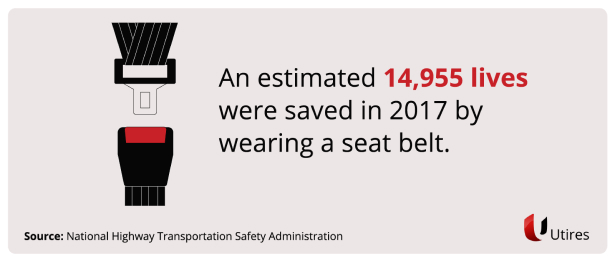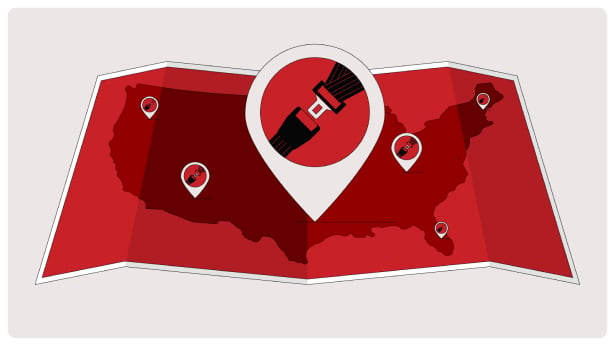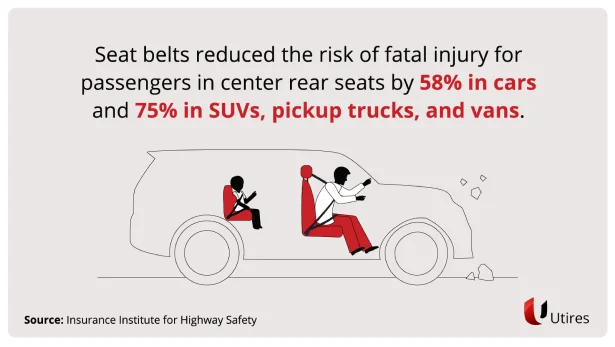Last Updated on 17.07.2021 by Mykhailo Savchuk
- According to the CDC, practicing seat belt safety “is one of the most effective ways to save lives and reduce injuries in crashes.”[1] But that’s not just an expert opinion; it’s backed up by traffic safety facts and cold, hard data.
- Statistically speaking, seat belt use saved the lives of 14,955 people ages 5 and older in 2017.[2]
- Plus, vehicle occupants are 30 times more likely to be ejected during a car accident if not wearing a seat belt.[3] That statistic becomes even more alarming when you realize that most ejection accidents are fatal: In fact, about three-quarters (75%) of people ejected in a crash die.

How Age and Gender Play a Part In Seat Belt Statistic
Age and gender play a part in seat belt statistics both positively and negatively.
- On the positive side, 91% of Americans ages 25 to 69 reported wearing a seat belt in 2019. That figure was even slightly higher for those ages 70 and older at 92%.[4]
Younger passengers were much less likely to wear seat belts:
- In 2019, more than four in 10 (43%) American high school students said they hadn’t always worn a seat belt in the previous month.
- Indeed, of the 22,697 people who died from motor vehicle crashes in 2018, more than half (between 51% and 60%) of those ages 13 to 44 weren’t buckled in at the time of the crash.
For even younger teens not yet old enough to drive, the results were often dire:
- In 2017, more than half (54%) of U.S. teens ages 13 to 15 who weren’t wearing a seat belt during car crashes were killed. Some were likely riding with older teens who were driving. According to the CDC, the presence of teen passengers increases the crash risk for unsupervised teen drivers.[5]
Although statistics showed a considerable gulf between older and younger drivers in terms of seat belt use, no comparable gap existed between genders:
- 93% of female front seat passengers wore a seat belt in 2019, similar to male occupants (89%).
Also, older drivers’ caution about their own safety seemed to translate to their young children:
- In 2017, child restraints saved the lives of 325 children ages 4 and younger. That was similar to seat belt usage.
Seat Belt Usage by State
- In 2019, seat belt usage by state ranged from more than 97% to barely 70%.
- Hawaii topped the list at 97.1%. It was followed by California (96%), Georgia (95.9%), and Oregon (95.7%). No other state topped the 95% mark.
- Nationwide, the rate of seat belt usage in 2017 was 90.7%. That was 4.5 percentage points higher than in 2012.
Seatbelt usage in:
Seat belt use correlates strongly with each state’s laws and enforcement procedures. How states apply seat belt laws falls into two general categories: primary enforcement and secondary enforcement.[6]
Primary seat belt laws allow an officer to ticket a driver or passenger in any vehicle for not wearing a seat belt, whether or not they’ve committed another infraction. Secondary laws, by contrast, only allow a no-seat belt ticket if another traffic infraction has occurred.
Jurisdictions with stronger seat belt enforcement laws continue to produce higher use rates than those with weaker laws.[7]
- For instance, Hawaii requires all vehicle occupants ages 8 and older to wear a seat belt whether they’re in the front or back seat. California has the same requirement for those 16 and older.[8]
- Oregon mandates seat belt usage for all occupants, regardless of age or where they’re sitting. All three are among the 35 states with primary enforcement.
- By contrast, South Dakota and Nebraska don’t require rear seat belt use at all and only practice secondary enforcement. Both states fell below the 80% usage rate in 2019.
- New Hampshire’s 70.7% rate is the lowest in the U.S. It has neither primary nor secondary enforcement. Its only restriction is a primary safety law for drivers and passengers younger than 18.

The percentage of seat belt usage by state in 2019 is as follows:[7]
-
- Alabama: 92.3%
- Alaska: 94.1%
- Arizona: 90.6%
- Arkansas: 81.9%
- California: 96%
- Colorado: 88.3%
- Connecticut: 93.7%
- Delaware: 92.5%
- District of Columbia: 95.4%
- Florida: 89.8%
- Georgia: 95.9%
- Hawaii: 97.1%
- Idaho: 85.7%
- Illinois: 94.3%
- Indiana: 94.9%
- Iowa: 94.6%
- Kansas: 84.9%
- Kentucky: 89.7%
-
- Louisiana: 87.5%
- Maine: 88.5%
- Maryland: 90.4%
- Massachusetts: 81.6%
- Michigan: 94.4%
- Minnesota: 93.4%
- Mississippi: 80.5%
- Missouri: 87.7%
- Montana: 88.9%
- Nebraska: 79.7%
- Nevada: 94.2%
- New Hampshire: 70.7%
- New Jersey: 90.2%
- New Mexico: 91.8%
- New York: 94.2%
- North Carolina: 88.4%
- North Dakota: 83.7%
- Ohio: 85.9%
-
- Oklahoma: 84.7%
- Oregon: 95.7%
- Pennsylvania: 88.6%
- Rhode Island: 88.3%
- South Carolina: 90.3%
- South Dakota: 75.2%
- Tennessee: 91.8%
- Texas: 90.9%
- Utah: 90.2%
- Vermont: 89.3%
- Virginia: 85.4%
- Washington: 93.1%
- West Virginia: 90.2%
- Wisconsin: 90.2%
- Wyoming: 78.3%
- Puerto Rico: 88.3%
-
- Alabama: 92.3%
- Alaska: 94.1%
- Arizona: 90.6%
- Arkansas: 81.9%
- California: 96%
- Colorado: 88.3%
- Connecticut: 93.7%
- Delaware: 92.5%
- District of Columbia: 95.4%
- Florida: 89.8%
- Georgia: 95.9%
- Hawaii: 97.1%
- Idaho: 85.7%
- Illinois: 94.3%
- Indiana: 94.9%
- Iowa: 94.6%
- Kansas: 84.9%
- Kentucky: 89.7%
- Louisiana: 87.5%
- Maine: 88.5%
- Maryland: 90.4%
- Massachusetts: 81.6%
- Michigan: 94.4%
- Minnesota: 93.4%
- Mississippi: 80.5%
- Missouri: 87.7%
-
- Montana: 88.9%
- Nebraska: 79.7%
- Nevada: 94.2%
- New Hampshire: 70.7%
- New Jersey: 90.2%
- New Mexico: 91.8%
- New York: 94.2%
- North Carolina: 88.4%
- North Dakota: 83.7%
- Ohio: 85.9%
- Oklahoma: 84.7%
- Oregon: 95.7%
- Pennsylvania: 88.6%
- Rhode Island: 88.3%
- South Carolina: 90.3%
- South Dakota: 75.2%
- Tennessee: 91.8%
- Texas: 90.9%
- Utah: 90.2%
- Vermont: 89.3%
- Virginia: 85.4%
- Washington: 93.1%
- West Virginia: 90.2%
- Wisconsin: 90.2%
- Wyoming: 78.3%
- Puerto Rico: 88.3%
Number of Lives Saved by Seat Belts in Each State
The number of lives saved by seat belts in each state in 2017 was by far the highest in Texas (1,775) and California (1,510). Both states have primary enforcement for all seats, large populations, and large geographic areas.
Texas and California ranked first and second, respectively, for seat belts worn by passengers 5 and older. They held the same spots for child restraints or booster seats used by passengers 4 and younger.
The number of lives saved by seat belts was lowest in New Hampshire (25), which has both minimal regulation and a small population. It was even lower (8) in the District of Columbia, which has a small geographic area and, therefore, fewer places to drive. (The same is true for Rhode Island at 25).
The number of lives saved by seat belts in each state for 2017 is as follows:[9]
-
- Alabama: 347
- Alaska: 36
- Arizona: 285
- Arkansas: 221
- California: 1,510
- Colorado: 229
- Connecticut: 112
- Delaware: 43
- District of Columbia: 8
- Florida: 1,107
- Georgia: 664
- Hawaii: 34
- Idaho: 95
- Illinois: 497
- Indiana: 447
- Iowa: 145
- Kansas: 204
- Kentucky: 343
-
- Louisiana: 291
- Maine: 71
- Maryland: 211
- Massachusetts: 61
- Michigan: 521
- Minnesota: 196
- Mississippi: 290
- Missouri: 318
- Montana: 73
- Nebraska: 74
- Nevada: 81
- New Hampshire: 23
- New Jersey: 241
- New Mexico: 158
- New York: 407
- North Carolina: 649
- North Dakota: 44
- Ohio: 470
-
- Oklahoma: 238
- Oregon: 263
- Pennsylvania: 360
- Rhode Island: 25
- South Carolina: 390
- South Dakota: 41
- Tennessee: 474
- Texas: 1,775
- Utah: 97
- Vermont: 28
- Virginia: 328
- Washington: 288
- West Virginia: 132
- Wisconsin: 293
- Wyoming: 43
- Puerto Rico: 68
-
- Alabama: 347
- Alaska: 36
- Arizona: 285
- Arkansas: 221
- California: 1,510
- Colorado: 229
- Connecticut: 112
- Delaware: 43
- District of Columbia: 8
- Florida: 1,107
- Georgia: 664
- Hawaii: 34
- Idaho: 95
- Illinois: 497
- Indiana: 447
- Iowa: 145
- Kansas: 204
- Kentucky: 343
- Louisiana: 291
- Maine: 71
- Maryland: 211
- Massachusetts: 61
- Michigan: 521
- Minnesota: 196
- Mississippi: 290
- Missouri: 318
-
- Montana: 73
- Nebraska: 74
- Nevada: 81
- New Hampshire: 23
- New Jersey: 241
- New Mexico: 158
- New York: 407
- North Carolina: 649
- North Dakota: 44
- Ohio: 470
- Oklahoma: 238
- Oregon: 263
- Pennsylvania: 360
- Rhode Island: 25
- South Carolina: 390
- South Dakota: 41
- Tennessee: 474
- Texas: 1,775
- Utah: 97
- Vermont: 28
- Virginia: 328
- Washington: 288
- West Virginia: 132
- Wisconsin: 293
- Wyoming: 43
- Puerto Rico: 68
Survival Rates of Wearing or Not Wearing a Seat Belt
Survival rates of wearing or not wearing a seat belt are dramatically different. In fact, statistics show that more than 47% of the 22,215 passengers who died in 2019 traffic crashes weren’t wearing a seat belt. Also, 55% of passengers killed at night weren’t restrained.
Seat Belt Survival Statistics and Facts
- Seat belt survival statistics show 2,549 lives could have been saved in 2017 alone if there was 100% seat belt usage.
- According to the National Highway Traffic Safety Administration (NHTSA), wearing a seat belt is the most effective way to survive a car crash.[10]
- NHTSA data reveals that seat belts saved 329,715 more lives between 1960 and 2012 than all other vehicle technologies combined.[11] That includes airbags, energy-absorbing steering assemblies, and electronic stability control.
Airbags are clearly no substitute for wearing a seat belt. Airbags are designed to work with seat belts, not as a replacement. Wearing a seat belt keeps occupants from moving at the same speed as the vehicle they’re in until they either stop or crash. Without that restraint, they’ll collide with the object in front of them at that speed. Even if that object is an airbag, it can cause serious injury.
- A study of front-seat passenger injuries from 1990 to 2002 in Pennsylvania confirmed this inability of airbags to provide the same level of protection as a seat belt in a crash.[12]
- It showed that drivers relying on airbags alone had a 54.1% rate of cervical fractures. That figure was 42.1% for those using both a seat belt and an airbag.
Even if a crash isn’t fatal, a seat belt helps prevent injury by spreading the force of impact across the strongest bones of the body. The role of force is why it’s essential to wear a seat belt properly; failure to do so can distribute the force of a crash to sensitive regions instead. That’s what happened to the woman in this study who was wearing the shoulder belt under her armpit when she hit a tree at 30 mph.[13] She suffered multiple injuries to her spleen, liver, colon, and left lower rib as a result.
- One more fact worth mentioning: Seat belt use not only improved safety in front seats but in rear seats as well. In center rear seats, the use of lap belts and shoulder belts reduced the risk of fatal injury by 58% (cars) and 75% (SUVs, pickup trucks, and vans) in 2017.

Consequences of Not Wearing a Seat Belt
The consequences of not wearing a seat belt can be severe.
- The NHTSA estimated in 1984 that a seat belt would reduce the fatality risk of front seat occupants in cars by about 45%. That’s compared to unrestrained occupants. For light trucks, the percentage was 60%. This study, released in 2000, is still relevant.[14]
The evidence shows that wearing a seat belt greatly reduces the chance of being killed or seriously hurt in a crash. So why would passengers decline to do so?
- A national telephone survey in 2012 by the Insurance Institute for Highway Safety (IIHS) provided some answers.[15] It showed the top reasons for not wearing a seat belt were discomfort, forgetfulness, and short-distance drives. (This last reason is despite the fact that a 2002 survey showed 52% of crashes occur within five miles of home and 77% happen within 15 miles of home.)[16]
- Some respondents who never wore a seat belt said they didn’t like being told what to do or didn’t think a seat belt was necessary. Another IIHS survey in 2016 found that adults in rear seats who didn’t buckle up mainly thought they were safer in the back.[17]
Given the potential consequences of not wearing a seat belt if you’re in a serious crash, is it worth the risk?
Seat Belt-Related Injuries
Can’t seat belts themselves cause injuries? Yes, but seat belt-related injuries are generally far less severe than injuries to those not wearing a seat belt.
Seat belts are a three-point adult harness resting on the shoulder, chest, and abdomen.
- When a car crashes, these three points are where most people can expect to find injuries .[18] The injuries that can occur from a seat belt in a crash are caused by the force of the impact. This can cause trauma to the neck, chest, or abdomen.
- Wearing a seat belt during a car crash will likely leave you with minor injuries compared to not wearing a seat belt, which is more likely to result in death.[19]
Even survivors of a car crash who weren’t wearing a seat belt may be left with serious injuries that could affect the rest of their lives. The outcome could be chronic pain and/or continuing medical bills.
- Crash injuries in 2012 led to $18 billion in lifetime medical costs, 25% of that coming more than 18 months after the crash. In addition, a crash in 2012 cost $33 billion in loss of work over a lifetime. Then, add in the toll that mental and emotional stress can take as a result of an accident.
A seat belt can minimize any injury caused by an accident and might even keep you alive. It’s not a matter of opinion; scientific studies and statistics bear it out. No matter how carefully you drive, you can’t control everything on the highway. And you can’t assume “that will never happen to me.” In fact, the opposite is true:
- Throughout a lifetime, you’re likely to be involved in three or four car accidents.[20] That data is based on insurance industry estimates that the average driver will file a collision claim once every 17.9 years — all the more reason to buckle up.
Sources
[1] Centers for Disease Control and Prevention. “Transportation Safety Seat Belts,”
https://www.cdc.gov/transportationsafety/seatbelts/index.html. Accessed May 23, 2021.
[2] U.S. Department of Transportation National Highway Traffic Safety Administration. “Seat Belt Use in 2019 – Overall Results,”
https://crashstats.nhtsa.dot.gov/Api/Public/ViewPublication/812875. Accessed May 23, 2021.
[3] Children’s Hospital of Philadelphia Research Institute. “Seat Belt Use: Facts and Stats,”
https://www.teendriversource.org/teen-crash-risks-prevention/rules-of-the-road/seat-belt-use-facts-and-stats. Accessed May 23, 2021.
[4] IIHS. “Seat Belts,”
https://www.iihs.org/topics/seat-belts#laws?topicName=safety-belts. Accessed May 23, 2021.
[5] Centers for Disease Control and Prevention. “Transportation Safety Get the Facts,”
https://www.cdc.gov/transportationsafety/teen_drivers/teendrivers_factsheet.html. Accessed May 23, 2021.
[6] GHSA. “Seat Belts,”
https://www.ghsa.org/state-laws/issues/seat%20belts. Accessed May 23, 2021.
[7] U.S. Department of Transportation National Highway Traffic Safety Administration. “Seat Belt Use in 2019 – Use Rates in the States and Territories,”
https://crashstats.nhtsa.dot.gov/Api/Public/ViewPublication/812947. Accessed May 23, 2021.
[8] GHSA. “Seat Belt Laws by State,”
https://www.ghsa.org/sites/default/files/2020-08/SeatBeltLaws_Aug20.pdf. Accessed May 23, 2021.
[9] U.S. Department of Transportation National Highway Traffic Safety Administration. “Lives Saved in 2017 by Restraint Use and Minimum-Drinking-Age Laws,”
https://crashstats.nhtsa.dot.gov/Api/Public/ViewPublication/812683. Accessed May 23, 2021.
[10] United States Department of Transportation NHTSA. “Seat Belts,”
https://www.nhtsa.gov/risky-driving/seat-belts. Accessed May 23, 2021.
[11] United States Department of Transportation NHTSA. “Seat Belts Save Lives,”
https://www.nhtsa.gov/seat-belts/seat-belts-save-lives. Accessed May 23, 2021.
[12] Spine. “Cervical Spine Injuries Associated With the Incorrect Use of Airbags in Motor Vehicle Collisions,”
https://journals.lww.com/spinejournal/Abstract/2008/03150/Cervical_Spine_Injuries_Associated_With_the.10.aspx. Accessed May 23, 2021.
[13] US National Library of Medicine National Institutes of Health. “The importance of wearing a seatbelt correctly – A case report of blunt trauma causing complete shearing transection of the gastroduodenal junction,”
https://www.ncbi.nlm.nih.gov/pmc/articles/PMC7298554/. Accessed May 23, 2021.
[14] U.S. Department of Transportation National Highway Traffic Safety Administration. “Fatality Reduction by Safety Belts for Front-Seat Occupants of Cars and Light Trucks,”
https://crashstats.nhtsa.dot.gov/Api/Public/ViewPublication/809199. Accessed May 23, 2021.
[15] IIHS. “Attitudes toward seat belt use and in-vehicle technologies for encouraging belt use,”
https://www.iihs.org/topics/bibliography/ref/2035. Accessed May 23, 2021.
[16] Autoweek. “Survey finds vehicle crashes most likely to occur close to home,”
https://www.autoweek.com/news/a2108966/survey-finds-vehicle-crashes-most-likely-occur-close-home/. Accessed May 23, 2021.
[17] IIHS. “Passenger use of and attitudes toward rear seat belts,”
https://www.iihs.org/topics/bibliography/ref/2141. Accessed May 23, 2021.
[18] US National Library of Medicine National Institutes of Health. “Seat Belt Injuries,”
https://www.ncbi.nlm.nih.gov/books/NBK470262/. Accessed May 23, 2021.
[19] Law Offices of Brian J. Elbaum. “The Dangers of Not Wearing a Seatbelt,”
https://www.elbaumlaw.com/the-dangers-of-not-wearing-a-seatbelt/. Accessed May 23, 2021.
[20] Forbes. “How Many Times Will You Crash Your Car?”
https://www.forbes.com/sites/moneybuilder/2011/07/27/how-many-times-will-you-crash-your-car/?sh=43aa33a64e62. Accessed May 23, 2021.

